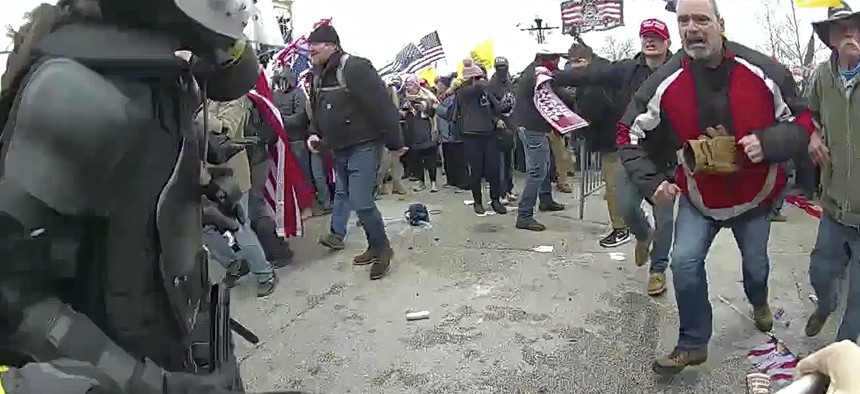
This still frame from Metropolitan Police Department body-worn camera video shows Thomas Webster, in red jacket, at a barricade line at on the west front of the U.S. Capitol on Jan. 6, 2021, in Washington. Webster, a Marine Corps veteran and retired New York City Police Department Officer, is accused of assaulting an MPD officer with a flagpole. Metropolitan Police Department via AP
Veterans Are Being Recruited by Extremist Groups. How Do We Help Them Say No?
Training must start while people are on active duty, experts said.
The “small but growing problem” of extremism among veterans is illustrated by the facts that they account for 15 percent of the people charged so far in the Jan. 6 attack on the U.S. Capitol—and that those charges figure heavily in the 350 percent increase in extremist-related crimes committed by veterans in the past decade, one terrorism expert said.
“But it's not just a numbers problem,” William Braniff, director of the National Consortium for the Study of Terrorism and Responses to Terrorism, said during a Brookings Institution panel on Friday. “This is a problem regarding American democracy. And it's a problem for which we have to put a preventative ecosystem in place now before the numbers do get more concerning.”
Since 1990 through the first nine months of 2021, at least 424 U.S. veterans “committed criminal acts that were motivated by their political, economic, social, or religious goals,” said a fact sheet released in October by the National Consortium for the Study of Terrorism and Responses to Terrorism, an academic effort led by the University of Maryland. That includes 99 veterans who have been charged with crimes related to the breach of the Capitol on Jan. 6.
Getting ahead of the problem is not a matter of prevention—it’s a matter of “pre-prevention,” said Cynthia Miller-Idriss, who runs American University’s Polarization and Extremism Research & Innovation Lab.
“We focus on the rhetorical strategies and narratives of persuasive tactics that extremist groups and propaganda use to try to recruit people. And then we design, in the lab, interventions that we test to see if we can interrupt those processes at the really early stage,” Miller-Idriss said. “It’s not even deradicalization or disengagement, but how do you prevent people from being persuaded by some of those extremist rhetorical strategies.”
That work needs to be part of their military service, said Shawn Turner, a senior advisor at the Department of Veterans Affairs.
“It needs to be baked into the training,” Turner said. “From the time that someone enters military service, we need to approach this issue with an understanding that whether it is while they're on active duty at one of our major bases around the country or whether it's during that time in their transition, or after they are out of the military—at every point of their career, they are in some way vulnerable to the rhetoric of these groups.”
Training people to be less vulnerable comes down to information.
“One of the things we have to do is invest during active duty...to actually have a stronger period of time where people are really coached to recognize propaganda, conspiracy theories, persuasive extremist tactics, scapegoating,” Miller-Idriss said.
There’s also the question of how to make the training stick long-term. The average time between when someone leaves the service and when they engage in criminal extremist activity is 10 years, Braniff said, so preventative training during service might not be enough.
“Our theory of change is that if we can harness the incredible strengths and talents of the veteran and military family community, and build on the foundation of civics, not politics, we can crowd out vulnerabilities related to extremism and polarizing mis- and dis-information,” he said.
And for those who do get pulled into extremist behavior or organizations, there must be resources for helping them get back out.
“We need to create an environment where people who want to leave conspiratorial or extremist movements can do so,” Braniff said. “They can find another veteran to help pull them back into prosocial behavior. Now, this requires resources, but it's an essential part of this overall risk mitigation strategy.”
“When it becomes patriotic to be against your government, then there's a problem there,” said Scott Cooper, non-resident fellow at the Atlantic Council. “We have a number of people, especially veterans, that are seeking some kind of meaning and purpose after they leave the service...and I think reestablishing that purpose in something meaningful is the challenge before us.”




